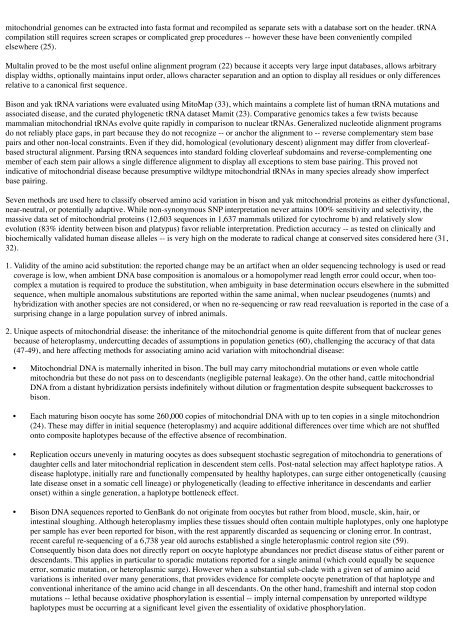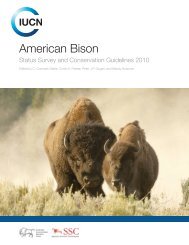Declaration Dr. Thomas H. Pringle - Buffalo Field Campaign
Declaration Dr. Thomas H. Pringle - Buffalo Field Campaign
Declaration Dr. Thomas H. Pringle - Buffalo Field Campaign
Create successful ePaper yourself
Turn your PDF publications into a flip-book with our unique Google optimized e-Paper software.
mitochondrial genomes can be extracted into fasta format and recompiled as separate sets with a database sort on the header. tRNA<br />
compilation still requires screen scrapes or complicated grep procedures -- however these have been conveniently compiled<br />
elsewhere (25).<br />
Multalin proved to be the most useful online alignment program (22) because it accepts very large input databases, allows arbitrary<br />
display widths, optionally maintains input order, allows character separation and an option to display all residues or only differences<br />
relative to a canonical first sequence.<br />
Bison and yak tRNA variations were evaluated using MitoMap (33), which maintains a complete list of human tRNA mutations and<br />
associated disease, and the curated phylogenetic tRNA dataset Mamit (23). Comparative genomics takes a few twists because<br />
mammalian mitochondrial tRNAs evolve quite rapidly in comparison to nuclear tRNAs. Generalized nucleotide alignment programs<br />
do not reliably place gaps, in part because they do not recognize -- or anchor the alignment to -- reverse complementary stem base<br />
pairs and other non-local constraints. Even if they did, homological (evolutionary descent) alignment may differ from cloverleafbased<br />
structural alignment. Parsing tRNA sequences into standard folding cloverleaf subdomains and reverse-complementing one<br />
member of each stem pair allows a single difference alignment to display all exceptions to stem base pairing. This proved not<br />
indicative of mitochondrial disease because presumptive wildtype mitochondrial tRNAs in many species already show imperfect<br />
base pairing.<br />
Seven methods are used here to classify observed amino acid variation in bison and yak mitochondrial proteins as either dysfunctional,<br />
near-neutral, or potentially adaptive. While non-synonymous SNP interpretation never attains 100% sensitivity and selectivity, the<br />
massive data set of mitochondrial proteins (12,603 sequences in 1,637 mammals utilized for cytochrome b) and relatively slow<br />
evolution (83% identity between bison and platypus) favor reliable interpretation. Prediction accuracy -- as tested on clinically and<br />
biochemically validated human disease alleles -- is very high on the moderate to radical change at conserved sites considered here (31,<br />
32).<br />
1. Validity of the amino acid substitution: the reported change may be an artifact when an older sequencing technology is used or read<br />
coverage is low, when ambient DNA base composition is anomalous or a homopolymer read length error could occur, when toocomplex<br />
a mutation is required to produce the substitution, when ambiguity in base determination occurs elsewhere in the submitted<br />
sequence, when multiple anomalous substitutions are reported within the same animal, when nuclear pseudogenes (numts) and<br />
hybridization with another species are not considered, or when no re-sequencing or raw read reevaluation is reported in the case of a<br />
surprising change in a large population survey of inbred animals.<br />
2. Unique aspects of mitochondrial disease: the inheritance of the mitochondrial genome is quite different from that of nuclear genes<br />
because of heteroplasmy, undercutting decades of assumptions in population genetics (60), challenging the accuracy of that data<br />
(47-49), and here affecting methods for associating amino acid variation with mitochondrial disease:<br />
• Mitochondrial DNA is maternally inherited in bison. The bull may carry mitochondrial mutations or even whole cattle<br />
mitochondria but these do not pass on to descendants (negligible paternal leakage). On the other hand, cattle mitochondrial<br />
DNA from a distant hybridization persists indefinitely without dilution or fragmentation despite subsequent backcrosses to<br />
bison.<br />
• Each maturing bison oocyte has some 260,000 copies of mitochondrial DNA with up to ten copies in a single mitochondrion<br />
(24). These may differ in initial sequence (heteroplasmy) and acquire additional differences over time which are not shuffled<br />
onto composite haplotypes because of the effective absence of recombination.<br />
• Replication occurs unevenly in maturing oocytes as does subsequent stochastic segregation of mitochondria to generations of<br />
daughter cells and later mitochondrial replication in descendent stem cells. Post-natal selection may affect haplotype ratios. A<br />
disease haplotype, initially rare and functionally compensated by healthy haplotypes, can surge either ontogenetically (causing<br />
late disease onset in a somatic cell lineage) or phylogenetically (leading to effective inheritance in descendants and earlier<br />
onset) within a single generation, a haplotype bottleneck effect.<br />
• Bison DNA sequences reported to GenBank do not originate from oocytes but rather from blood, muscle, skin, hair, or<br />
intestinal sloughing. Although heteroplasmy implies these tissues should often contain multiple haplotypes, only one haplotype<br />
per sample has ever been reported for bison, with the rest apparently discarded as sequencing or cloning error. In contrast,<br />
recent careful re-sequencing of a 6,738 year old aurochs established a single heteroplasmic control region site (59).<br />
Consequently bison data does not directly report on oocyte haplotype abundances nor predict disease status of either parent or<br />
descendants. This applies in particular to sporadic mutations reported for a single animal (which could equally be sequence<br />
error, somatic mutation, or heteroplasmic surge). However when a substantial sub-clade with a given set of amino acid<br />
variations is inherited over many generations, that provides evidence for complete oocyte penetration of that haplotype and<br />
conventional inheritance of the amino acid change in all descendants. On the other hand, frameshift and internal stop codon<br />
mutations -- lethal because oxidative phosphorylation is essential -- imply internal compensation by unreported wildtype<br />
haplotypes must be occurring at a significant level given the essentiality of oxidative phosphorylation.










